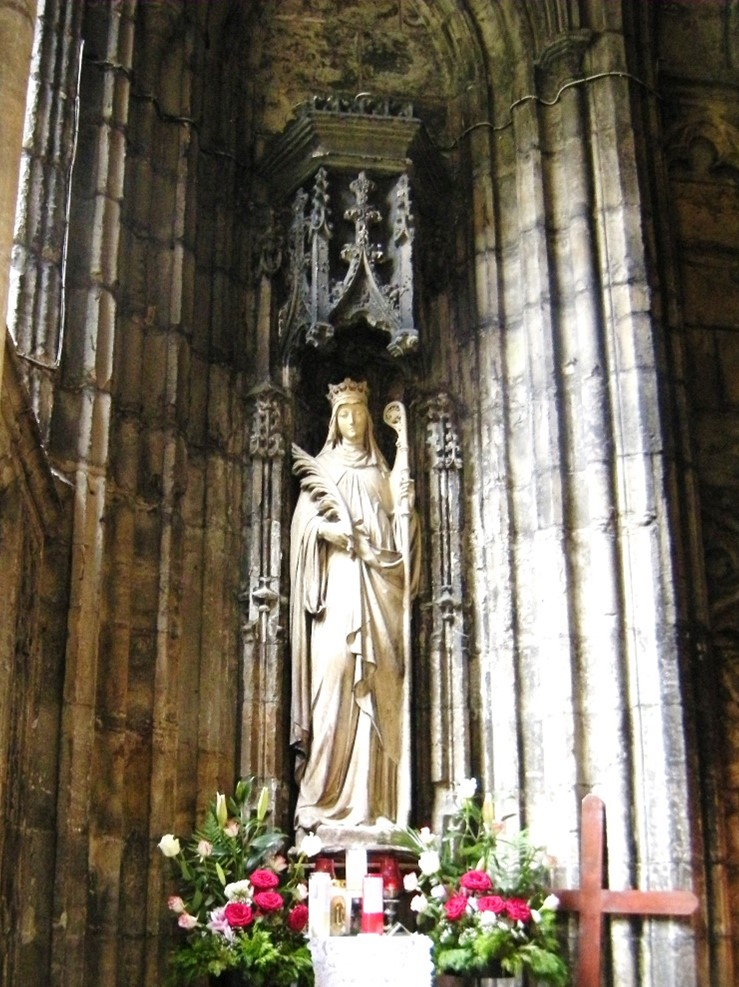
Father Michael Fuller, a scholar of the Pontifical University of St Mary of the Lake, USA, [1] quotes D.W. Robertson suggests the Virgin Martyrs’ Vitae be read as ‘historical criticism’-as ‘a kind of literary analysis seeking to reconstruct the intellectual attitudes and the cultural ideals of a period to reach a fuller understanding of its literature.’[2] He believed medieval literature was ‘saturated with Christian symbols and theology’ now a lost concept for many. Felice Lifshitz has argued that the idea of hagiography as a specific genre is an idealistic construct, a tool that had no function in the ninth to eleventh centuries, for this did not exist as a conceptual category and should not be anachronistically applied to their analysis.[3] These ‘ Virgin Martyr’ accounts are not historical artifacts or disrespected ‘fables’. They were sources of Christian inspiration and spiritual growth. The Pontifical Commission has now affirmed that such texts are open to a plurality of meanings, because of new theories of language, and philosophical hermeneutics .[4] In this light, in the second part of this blog, I propose to examine St Winifred’s mission and theological purpose.[5]
Saint Winefride, is the patroness of Wales, and is one of few saints, by the renaissance period to have an important cult in England, with an outreach to London.[6] Royal pilgrims made visits. Important pilgrimages still take place every year from various organisations-especially Irish pilgrims who disembark at Liverpool. This shrine has attested miracles going back to its very beginning, is almost unknown to many. Saint Winefride defended her chastity by escaping from a lusty nobleman who had tried in vain to seduce her then decapitated her in a fit of rage. A fountain sprang up where her head fell near the church door. A different ‘slant’ on this story in the Vita Secunda is that the suitor had fallen in love with her and wanted marriage. Winefride’s uncle, St Beuno (well attested as a saint reputed already to have restored seven others to life!) re-joined her head, covered her with his cloak and finished singing Mass before coming back to raise her to life. Her neck bore the red scar, a testament to the goodness of God for the rest of her life and made her personally an object of pilgrimage during fifteen more years of life at the Convent at Gwytherin, where many came to consult her before she died and was subsequently interred. Her remains were later ‘translated’ to Shrewsbury Abbey to a splendid Benedictine shrine. She produced many miracles in Shrewsbury but also at Holywell at which her involvement with the fountain (her ‘blood’ spilt into it and the reddish moss in the well, known as her ‘hair’) miracles continued.
The Vita Prima[7], describes many aspects of seventh century life in Holywell, even Norman attacks. Firstly, we learn that Winifred (Welsh Gwenfrewi) was a real, historical person with a genealogy linked to three saints’ families in Glywyssing, Brecon and Powys. So she was no fairy tale or ‘goddess’ figure. We learn she begged her parents to allow her to be a Bride of Christ, which they reluctantly did, asking Uncle Beuno to come and instruct her (he was educated at the prestigious college of Tatheus in Caerwent). Winefride was their only child-so her parents had hoped for a good marriage. Girls wanting to be nuns in the seventh century lived with parents and were schooled by a local priest, until old enough to join a convent.
Was this just another fabulous and pious legend? The first Eucharistic Prayer at Mass prays for a group of male and female martyrs the latter named as Felicity, Perpetua, Agatha, Lucy, Agnes, Cecilia, Anastasia. We could add many more—Catherine, Margaret, and Barbara. All gave their lives to be Christ-like choosing chastity to join themselves irrevocably to God. Roman women could not refuse arranged marriages, but the virgin martyrs’ disgruntled suitors could only avenge themselves by calling them out as Christians and cruel persecutions ensued. St Ambrose drew an interesting perspective, Vir–ago (celebrate-as a man). Virgins could be dealt with as celibate men, as the ‘hundred fruits of heaven’. (Widows sixty fold, Wives thirty fold)[8]. They did not die for their chastity. Their concern echoed as Christ’s, for the immortal souls of their attackers; a concept far more than a simple concern for purity. Their immortal souls were more important. What, then could St Winefride’s teaching add to the stories? To be continued…
[1] Fuller, M., The Virgin Martyrs. Hildebrand Books Studies, pp.22-3.
[2] D.W. Robertson, Essays in Medieval Culture. Princeton University Press, Princeton, NJ, 1980, p.3.
[3] Litshitz, F., Beyond Positivism and genre: ’Hagiographical texts’ as Historical Narrative, Viator 25 (1994), p.113.
[4] Pontificia Commissione Biblica, L’Interpretation de la Bible dans l’église.(Vatican City :Librera Editice Vaticana, 1993) section IIB, translation in Origins 23.No 29. (January 6th 1994), p.511.
[5] MSS: Bodleian, Laud Misc.MS114, (Vita Secunda),British Lib.BL Cotton Claudius A.v.1200.(Vita Prima). Many more copies exist.
[6] There were links between the Shrewsbury Confraternity of St Winifred, established by Abbot Thomas Mynde 1487and the Mercers’ company in London.. For this reason, the story of Winefride came into Caxton’s sights. Of Mice and Men,Image Belief and Regulation in Medieval England. Anne Sutton, p.118.
[7] Also known as the ‘Anonymous Life’, thought to be composed by a local monk possibly from St Werbergh’s Abbey, Chester.
[8] Mt 13:23 Cyprian interprets these ‘fruits’ as to virginity. St Augustine (De Virginitate 46)thinks the scheme is (Fr Fuller writes) too simplistic. It is the gift which gives glory to God.’ Sometimes one receives fewer gifts but greater ones, and another receives lesser gifts but more of them. ’The Works of St Augustine: A Translation for the 21st century. (Hyde Park. New City Press, N.Y,1999, pp.98-99.
Thank you to Evelyn Nicholson, MBIT student who submitted the first of two articles about St Winefride.



